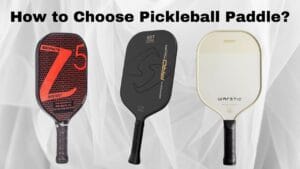A perforated ball hit over a net using a padel racket! That’s pickleball for you, a game having the characteristics of badminton, tennis, and ping pong ball!
If you’re looking to build an outdoor pickleball court, you need to consider a few things. This includes the space, the surface flooring, the fence, the net, etc.
How much space do you need? What sort of material is required? Which is the best type of flooring for the pickleball court? What sort of net should you get? And what kind of lighting would be perfect for the court? We will answer all these queries and more.
And by the time you finish reading this article, you will know all the ins and outs of building an outdoor pickleball court.
So, let’s get started!
We will take you through all the aspects of building an outdoor pickleball court from scratch.
Pickleball Court Dimensions
When you set out to build a sports court, the space is what matters the most. So, when it comes to building a pickleball court, you should know the dimensions of a pickleball court.
The total area required for a pickleball court is 34 feet x 64 feet, but if you’re short by a few inches, a 30 feet x 60 feet court will do as well. This area is inclusive of the perimeter fencing and sidelines. However, the actual area where the game is played has a dimension of 20 feet x 40 feet, whether you’re building a single or double court. Therefore, the first step in building an outdoor pickleball court is to determine the space based on the pickleball court dimensions.
If you have enough space to build a pickleball court easily, it’s time to move on to the next step…
Choosing Court Surface Flooring
The flooring is the most important aspect to consider when building an outdoor sports court. You should choose the flooring based on the type of sport that you will use the court for.
In the case of pickleball, the perforated polymer ball with which the sport is played requires a firm surface to bounce. The usual flooring options for an outdoor pickleball court are concrete or asphalt. However, both these surfaces cannot withstand harsh weather conditions. For instance, they might chip or crack when faced with heavy rain and can get uneven due to waterlogging.
So, even if you choose concrete or asphalt flooring, you might save some money, but it’s not a viable option for the long run.
Why not go for something less expensive and can last for more than a decade? We’re talking about the Copo Sport’s state-of-the-art flooring, the Macwood Standard Outdoor Pickleball Court Flooring system that, for the first time in the history of sports courts, offers a hardwood floor-like experience in the open.
The Macwood Standard Outdoor Flooring is an excellent option for a competitive pickleball game. It also ensures the health of the players’ joints with its outstanding athletic performance, shock reduction, and slip resistance.
However, Copo Sports also has the Rebounce interlocking tiles from its Copo Dura series if you’re looking for a more pocket-friendly option. These tiles are made of hard and durable polypropylene material that offers extra ball bounce and an excellent grip and traction for fast gameplay.
Therefore, if you want to get your money’s worth, invest in Copo Sports flooring for your outdoor pickleball court.
Now that you have chosen the flooring for your outdoor pickleball court, it’s time to look at other aspects that refine and complete your sports court.
Perimeter Fencing
The perimeter fencing also plays an important role in building a sports court because it keeps the ball within the court. Plus, it also acts as a security measure for the players.
So, what sort of fences should you get for the perimeter? And, how high should it be?
If you’re looking for a cost-effective option, we suggest getting a chain-link fence; however, it is not very durable as it can be easily cut and unraveled. Another option is the Orange construction fencing, which is cost-effective yet durable and rigid enough for crowd control. Plus, it can withstand all sorts of environmental changes.
Then we have the steel wire fencing. It is the best option for sports court perimeter fencing, as it is heavy-duty and durable.
As for the height, the perimeter fence of an outdoor pickleball court is usually 10 feet high, but if you’re using a padded fence, 4 to 5 feet is also good enough.
So, choose a perimeter fence for your outdoor pickleball court based on your budget, requirements, and of course, preference.
Lighting System
As pickleball is quite a fast-paced game, it requires lighting that is evenly spread out across the court. Although the more the light, the better, you can still go for as much lighting as your budget allows.
The usual lighting arrangement in an outdoor pickleball court is two 20-feet light poles with 1500-watt lights, situated in the center of the court, 5 feet from the sidelines.
You can choose the lights according to your requirements. For instance, if you’re looking for lights with the maximum output, high-intensity discharge lamps (HID) are a good choice; however, they only last for 12000 hours on average.
Therefore, a low-maintenance and long-lasting option would be LED lighting. They last for up to 120,000 hours and can be used with dimmers.
Regardless of which lights you choose for your outdoor pickleball court, ensure the wiring is underground and outside the court area for safety purposes.
Pickleball Net Systems
Once you have determined all the basics of your outdoor pickleball court, it’s time to turn your attention toward the netting for the game. The netting system for pickleball consists of two poles to hold the net, a ratchet, a pickleball net, and sleeves.
According to the USAPA, the pickleball net should be 21 feet and 9 inches long and 30 inches tall. The net should be 36 inches above the ground, while from the center, it should be 34 inches above ground level.
By now, you have an exact idea of the pickleball court dimensions, the flooring requirements for an outdoor pickleball court, the material and dimensions of the perimeter fencing, the lighting for the court, and the pickleball netting system.
Once you decide on the material you want, it’s time to get to work!
Setting Up Your Pickleball Court
If you’re building a pickleball court for your backyard, you can set it up yourself. However, we suggest hiring a contractor to set it up for professional or commercial-level outdoor pickleball courts.
Also, you should consider the north-south alignment of the court to avoid shadows on the court or direct sunlight that might obstruct the players’ view.
Once everything is in place, you can mark the court lines using acrylic paint, sidewalk chalk, orange tape, or contractor’s chalk dust. Whatever marking tool you choose, ensure the lines are 2 inches wide in white for better visibility.
Voila! Your outdoor pickleball court is ready for a competitive game!
Frequently Asked Questions
If you’re building an outdoor pickleball court, here are some common queries that might help you out:
Q. How much does it cost to build a pickleball court?
The cost of building a pickleball court depends on the quality of the material you are using for the court. But, for a regular 30 feet x 60 feet court, the average cost is somewhere around $40k to 45k, give or take a few.
Q. What kind of base is required for a pickleball court?
A pickleball court requires a firm, smooth, and durable surface for the perforated ball to bounce properly. Therefore, concrete, asphalt, or interlocking polypropylene tiles are a good option for a pickleball court base.
Q. What are the best color combinations for use on a pickleball court?
There is no wrong color combination for a pickleball court; however, we recommend using colors that contrast with the pickleball for quick spotting during gameplay.
Q. What kind of coating should be used to surface, or paint, pickleball courts?
You should use 100% acrylic coating to surface or paint pickleball courts.
Q. How should pickleball courts be cleaned?
You can clean pickleball courts with pressure washers or floor scrubbers. But make sure that the brush bristles are soft to avoid damaging the surface.
Conclusion
Pickleball is gaining popularity with each passing day; therefore, if you’re looking to build a solid court for the game, this article will help you with everything you need to know about building an outdoor pickleball court.
From the pickleball court dimensions to the flooring, lighting, netting, and fencing, you will find all the basics of making a durable pickleball court. So, go out there, pick your material, and get working!








